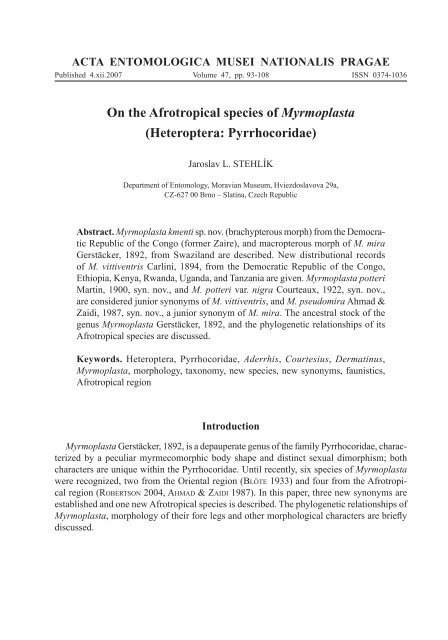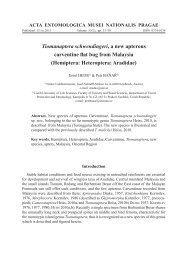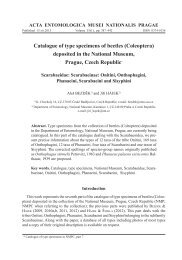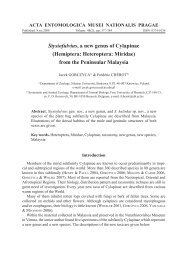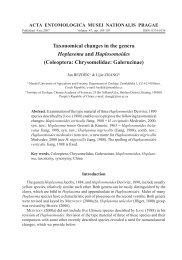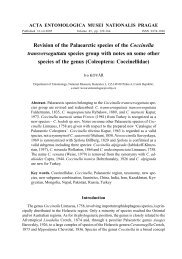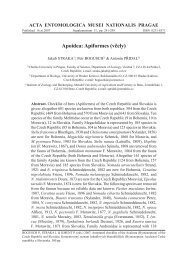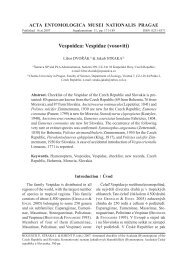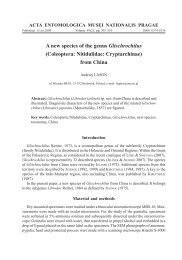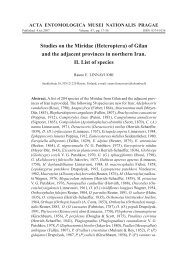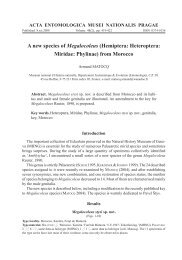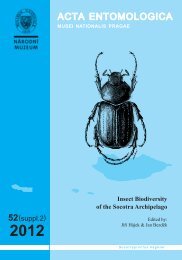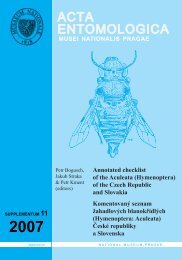On the Afrotropical species of Myrmoplasta - Acta Entomologica ...
On the Afrotropical species of Myrmoplasta - Acta Entomologica ...
On the Afrotropical species of Myrmoplasta - Acta Entomologica ...
Create successful ePaper yourself
Turn your PDF publications into a flip-book with our unique Google optimized e-Paper software.
ACTA ENTOMOLOGICA MUSEI NATIONALIS PRAGAE<br />
Published 4.xii.2007 Volume 47, pp. 93-108 ISSN 0374-1036<br />
<strong>On</strong> <strong>the</strong> <strong>Afrotropical</strong> <strong>species</strong> <strong>of</strong> <strong>Myrmoplasta</strong><br />
(Heteroptera: Pyrrhocoridae)<br />
Jaroslav L. STEHLÍK<br />
Department <strong>of</strong> Entomology, Moravian Museum, Hviezdoslavova 29a,<br />
CZ-627 00 Brno – Slatina, Czech Republic<br />
Abstract. <strong>Myrmoplasta</strong> kmenti sp. nov. (brachypterous morph) from <strong>the</strong> Democratic<br />
Republic <strong>of</strong> <strong>the</strong> Congo (former Zaire), and macropterous morph <strong>of</strong> M. mira<br />
Gerstäcker, 1892, from Swaziland are described. New distributional records<br />
<strong>of</strong> M. vittiventris Carlini, 1894, from <strong>the</strong> Democratic Republic <strong>of</strong> <strong>the</strong> Congo,<br />
Ethio pia, Kenya, Rwanda, Uganda, and Tanzania are given. <strong>Myrmoplasta</strong> potteri<br />
Martin, 1900, syn. nov., and M. potteri var. nigra Courteaux, 1922, syn. nov.,<br />
are considered junior synonyms <strong>of</strong> M. vittiventris, and M. pseudomira Ahmad &<br />
Zaidi, 1987, syn. nov., a junior synonym <strong>of</strong> M. mira. The ancestral stock <strong>of</strong> <strong>the</strong><br />
genus <strong>Myrmoplasta</strong> Gerstäcker, 1892, and <strong>the</strong> phylogenetic relationships <strong>of</strong> its<br />
<strong>Afrotropical</strong> <strong>species</strong> are discussed.<br />
Keywords. Heteroptera, Pyrrhocoridae, Aderrhis, Courtesius, Dermatinus,<br />
<strong>Myrmoplasta</strong>, morphology, taxonomy, new <strong>species</strong>, new synonyms, faunistics,<br />
<strong>Afrotropical</strong> region<br />
Introduction<br />
<strong>Myrmoplasta</strong> Gerstäcker, 1892, is a depauperate genus <strong>of</strong> <strong>the</strong> family Pyrrhocoridae, characterized<br />
by a peculiar myrmecomorphic body shape and distinct sexual dimorphism; both<br />
characters are unique within <strong>the</strong> Pyrrhocoridae. Until recently, six <strong>species</strong> <strong>of</strong> <strong>Myrmoplasta</strong><br />
were recognized, two from <strong>the</strong> Oriental region (BLÖTE 1933) and four from <strong>the</strong> <strong>Afrotropical</strong><br />
region (ROBERTSON 2004, AHMAD & ZAIDI 1987). In this paper, three new synonyms are<br />
established and one new <strong>Afrotropical</strong> <strong>species</strong> is described. The phylogenetic relationships <strong>of</strong><br />
<strong>Myrmoplasta</strong>, morphology <strong>of</strong> <strong>the</strong>ir fore legs and o<strong>the</strong>r morphological characters are briefl y<br />
discussed.
94<br />
STEHLÍK: <strong>On</strong> <strong>the</strong> <strong>Afrotropical</strong> <strong>species</strong> <strong>of</strong> <strong>Myrmoplasta</strong><br />
Material and Methods<br />
The following codens are used for <strong>the</strong> collections mentioned in this study:<br />
AMNH American Museum <strong>of</strong> Natural History, New York, USA;<br />
BMNH Natural History Museum, London, United Kingdom;<br />
MMBC Moravian Museum, Brno, Czech Republic;<br />
MNHN Muséum National d’Histoire Naturelle, Paris, France;<br />
MRAC Musée Royal d’Afrique Centrale, Tervuren, Belgium;<br />
ZMAN Zoölogisch Museum, University <strong>of</strong> Amsterdam, Ne<strong>the</strong>rlands;<br />
ZMAS Zoological Institute, Russian Academy <strong>of</strong> Sciences, St. Petersburg, Russia;<br />
ZMHB Zoologisches Museum, Humboldt Universität, Berlin, Germany.<br />
Results<br />
<strong>Myrmoplasta</strong> kmenti sp. nov.<br />
(Figs. 1, 3-7)<br />
<strong>Myrmoplasta</strong> mira: SCHOUTEDEN (1957): 266 (misidentifi cation).<br />
Material examined. HOLOTYPE: � (brachypterous), DEMOCRATIC REPUBLIC OF THE CONGO: KINSHASA<br />
PROVINCE, Kisantu, 1932, R. P. Vanderyst (MRAC). PARATYPES (3 ��, brachypterous): DEMOCRATIC REPUBLIC<br />
OF THE CONGO: KINSHASA PROVINCE, Mayidi, 1942, 2 ��, Rév. P. van Eyen (MRAC); ditto, 1945, 1 �, Rév.<br />
P. van Eyen (MRAC).<br />
Description (��, brachypterous morph – Fig. 1). Body black. Posterior margin <strong>of</strong> pronotum<br />
very narrowly bordered with yellow; distal margin <strong>of</strong> hemelytra with narrow yellow border,<br />
slightly widening apicad but not reaching <strong>the</strong> apex <strong>of</strong> shortened hemelytra. Connexival<br />
membrane and, to a varying degree, laterotergites <strong>of</strong> females red. Parameres and lateral rim<br />
infolding on pygophore pale yellow.<br />
Head <strong>of</strong> male (Fig. 3) more horizontally positioned and less convex than in female (Fig. 4).<br />
Antennae <strong>of</strong> male relatively short (missing in all studied females). Antennomere 2 stout,<br />
slightly spindel-shaped; antennomere 3 strongly spindel-shaped (i.e. strongly widening from<br />
base and narrowed before apex), about 1.4 times as thick as antennomere 2; antennomere 4<br />
quite stout, slightly less than 0.8 times as thick as antennomere 3. Gula <strong>of</strong> male only very<br />
slightly convex (in lateral view), in female slightly more convex.<br />
Pronotum long and narrow (Figs. 3-4). Callar lobe (including lateral margins) in male<br />
1.23 times, in females 1.22 times as wide as base <strong>of</strong> pronotum; callar lobe (without pronotal<br />
collar) <strong>of</strong> male 2.3 times, in female 2.5 times as long as pronotal lobe; callar lobe (including<br />
lateral margins) <strong>of</strong> male 1.30 times, <strong>of</strong> female 1.08 times as wide as interocular distance.<br />
Lateral margins <strong>of</strong> callar lobe strongly heart-shaped. Callar lobe distinctly higher than pronotal<br />
lobe (especially in male) and strongly sloping towards it. Pronotum between callar and<br />
pronotal lobe considerably narrowed. Distal part <strong>of</strong> pronotal lobe straight, its proximal part<br />
slightly lifted. Mesoscutellum with distinct median longitudinal furrow, in male 1.16 times,<br />
in female 1.10 times as long as wide. Mesoscutellum fused with hemelytra, <strong>the</strong> latter fused<br />
toge<strong>the</strong>r. Each hemelytron (Figs. 3-4) relatively long, narrow, its margin (except <strong>of</strong> base)<br />
more strongly raised upwards, regularly rounded, a bit narrowed before apex; distal angles
<strong>Acta</strong> <strong>Entomologica</strong> Musei Nationalis Pragae, 47, 2007 95<br />
Fig. 1. <strong>Myrmoplasta</strong> kmenti sp. nov., brachypterous male, holotype (orig. J. Meduna).
96<br />
STEHLÍK: <strong>On</strong> <strong>the</strong> <strong>Afrotropical</strong> <strong>species</strong> <strong>of</strong> <strong>Myrmoplasta</strong><br />
<strong>of</strong> hemelytra slightly produced, convergent, and rounded. Fore femora strongly swollen with<br />
three teeth in male.<br />
Abdomen nearly spherical, strongly constricted basally (Figs. 5-6); tergum considerably<br />
gibbous. Mesotergite II small, mesotergites III-V distinctly large, mesotergite VI <strong>of</strong> male<br />
nearly vertically positioned. Abdomen apically narrowed, mesotergite VII narrow, horizontally<br />
positioned in male, its distal margin bent dorsally. Pygophore not retractable into abdomen<br />
(Fig. 1).<br />
Pygophore. Ventral wall submedially with rounded depression under ventral rim; prominent<br />
longitudinal groove under this depression. Ventral rim only slightly elevated above<br />
Fig. 2. <strong>Myrmoplasta</strong> vittiventris Carlini, 1894, brachypterous male (orig. J. L. Stehlík).
<strong>Acta</strong> <strong>Entomologica</strong> Musei Nationalis Pragae, 47, 2007 97<br />
Figs. 3-7. <strong>Myrmoplasta</strong> kmenti sp. nov. 3-4 – head and thorax, dorsal view: 3 – male; 4 – female. 5-6 – abdomen,<br />
male: 5 – dorsal view; 6 – lateral view. 7 – outer female genitalia.<br />
lateral rims; both ventral and lateral rims with sharp edge, continually and roundly merging<br />
into each o<strong>the</strong>r. Infolding <strong>of</strong> lateral rims very broad, both sides <strong>of</strong> <strong>the</strong>se bent under ventral<br />
rim and nearly contiguous, ventral rim infolding thus not apparent; anterior part <strong>of</strong> lateral<br />
rim infoldings shallowly dish-like deepened, almost horizontal; <strong>the</strong>ir posterior part smaller,<br />
nearly vertically declivous and abruptly narrowed. Parameres placed nearly in <strong>the</strong> middle<br />
<strong>of</strong> genital chamber, <strong>the</strong>ir basal part slightly lopsided medially and than bent over <strong>the</strong> lateral<br />
rim infolding; <strong>the</strong>ir apex narrowed into a tip and very slightly curved. Anal tube positioned<br />
horizontally, reaching nearly <strong>the</strong> parameres.
98<br />
STEHLÍK: <strong>On</strong> <strong>the</strong> <strong>Afrotropical</strong> <strong>species</strong> <strong>of</strong> <strong>Myrmoplasta</strong><br />
Outer female genitalia (Fig. 7). Inner margin <strong>of</strong> valvifer 1 convexly arcuate, reaching<br />
<strong>the</strong> middle <strong>of</strong> genitalia. Anal tube short, closely under tergite VIII. Laterotergite IX raised,<br />
rounded, dish-shaped deepened, with horizontal groove medially. Valvifer 2 visible, medially<br />
deepened, with longitudinal projection laterally on each side; <strong>the</strong>se projections deepened from<br />
<strong>the</strong>ir inner and under side, and apically horizontally ridged.<br />
Measurements. Male (holotype). Body length 6.48 mm. Head: width (including eyes) – 1.84<br />
mm, interocular width – 1.08 mm; antenna: lenght <strong>of</strong> antennomeres 1 – 1.24 mm, 2 – 1.35<br />
mm, 3 – 1.05 mm, 4 – 1.76 mm; pronotum: total length – 1.16 mm, collar lenght – 0.08 mm,<br />
callar lobe: length – 0.76 mm, width (including margins) – 1.40 mm, pronotal lobe: length<br />
– 0.32 mm, width – 1.13 mm; scutellum: length – 0.76 mm, width – 0.65 mm; hemelytron:<br />
length – 1.40 mm, width – 0.59 mm.<br />
Female (paratypes) (mean with full range in paren<strong>the</strong>ses). Body length 7.37 mm (7.13-7.68<br />
mm). Head: width (including eyes) – 2.13 mm (2.05-2.19 mm), interocular width – 1.32 mm<br />
(1.19-1.35 mm); antennae absent in all paratypes; pronotum: total length – 1.25 mm, collar<br />
lenght – 0.11 mm, callar lobe: length – 0.84 mm (0.81-0.86 mm), width (including margins)<br />
– 1.57 mm (1.46-1.62 mm), pronotal lobe: length – 0.29 mm (0.27-0.30 mm), width – 1.28 mm<br />
(1.19-1.35 mm); scutellum: length – 0.93 mm (0.89-0.97 mm), width – 0.83 mm (0.76-0.97<br />
mm); hemelytron: length – 1.37 mm (1.32-1.43 mm), width – 0.63 mm (0.59-0.65 mm).<br />
Variability. No apparent variability was observed among <strong>the</strong> studied specimens, except <strong>the</strong><br />
measurements given above.<br />
Differential diagnosis. <strong>Myrmoplasta</strong> kmenti sp. nov. differs from <strong>the</strong> o<strong>the</strong>r <strong>Afrotropical</strong><br />
<strong>species</strong> <strong>of</strong> <strong>the</strong> genus by characters given in <strong>the</strong> key below.<br />
Etymology. This <strong>species</strong> is dedicated to Petr Kment, curator <strong>of</strong> <strong>the</strong> Hemiptera collection in<br />
National Museum in Prague.<br />
Bionomics. Unknown.<br />
Distribution. Known only from <strong>the</strong> Kinshasa province in <strong>the</strong> Democratic Republic <strong>of</strong> <strong>the</strong><br />
Congo (former Zaire).<br />
<strong>Myrmoplasta</strong> mira Gerstäcker, 1892<br />
(Figs. 8-10)<br />
<strong>Myrmoplasta</strong> mira Gerstäcker, 1892: 51. HOLOTYPE: �, Tanzania, Rosako, Usaramo, August [18]88 (depository<br />
unknown – see Note).<br />
<strong>Myrmoplasta</strong> mira: ROBERTSON (2004): 21 (catalogue).<br />
<strong>Myrmoplasta</strong> pseudomira Ahmad & Zaidi, 1987: 47-49, syn. nov. HOLOTYPE: �, Malvern, 22-1-19, 215 (BMNH).<br />
Type material examined. <strong>Myrmoplasta</strong> pseudomira. HOLOTYPE: �, REPUBLIC OF SOUTH AFRICA: KWAZULU-<br />
NATAL, Malvern, 22-1-19, 215 (BMNH).<br />
Additional material examined. TANZANIA: ZANZIBAR, no fur<strong>the</strong>r data, 1 � (brachypterous) (BMNH). REPUB-<br />
LIC OF SOUTH AFRICA: KWAZULU-NATAL, Ngongoni Veld, 12.ii.1975, 1 � (brachypterous), P. E. Reavell lgt.<br />
(BMNH); Port Shepstone, no fur<strong>the</strong>r data, 1 � (brachypterous) (BMNH). SWAZILAND: Eranchi, xii.1957, 1 �<br />
(macropterous), A. L. Capener leg. (AMNH).<br />
Description <strong>of</strong> macropterous morph (�, Swaziland: Eranchi). Body black, slightly more than<br />
basal two thirds <strong>of</strong> pronotal lobe pale yellow; pale yellow spot anterior <strong>of</strong> apical angle <strong>of</strong> corium<br />
(on costal margin) wide, nearly triangularly narrowed towards <strong>the</strong> inner margin <strong>of</strong> corium,<br />
covering almost one quarter <strong>of</strong> total length <strong>of</strong> corium; laterotergites IV-V yellowish.
<strong>Acta</strong> <strong>Entomologica</strong> Musei Nationalis Pragae, 47, 2007 99<br />
Figs. 8-10. <strong>Myrmoplasta</strong> mira Gerstäcker, 1892, macropterous male. 8 – anterior part <strong>of</strong> body; 9 – thorax, lateral<br />
view; 10 – remigium (rest <strong>of</strong> <strong>the</strong> wing absent).<br />
Head large, vertex strongly convex (Fig. 8). Antennae long, antennomere 1 1.32 times as<br />
long as interocular distance, antennomere 3 as long as <strong>the</strong> interocular distance; antennomere<br />
1 more strongly widened towards apex, antennomere 2 more slightly widened, antennomere<br />
3 distinctly widened towards apex (but not spindel-shaped). Bucculae large and high.<br />
Pronotal collar (in lateral view, Fig. 9) distinctly lowered below callar lobe; pronotal lobe<br />
strongly convex above <strong>the</strong> level <strong>of</strong> callar lobe, strongly widened laterad (in dorsal view) and<br />
slighly lowered next to humeral humps, at base 1.56 times as wide as callar lobe (including<br />
lateral margins), 1.18 times as long as callar lobe (without pronotal collar). Base <strong>of</strong> pronotum<br />
1.58 times as wide as pronotum long. Lateral margins <strong>of</strong> pronotum only slightly narrowing<br />
towards base. Scutellum large. Hemelytra with clavus and membrana well-developed; costal<br />
margin <strong>of</strong> corium more strongly arched outwards, its distal margin rounded towards apex.<br />
Delimitation <strong>of</strong> corium and membrane less apparent, especially in distal angle; clavus and<br />
corium roughly and hardly regularly punctured. Hind wings (Fig. 10) fully developed, slightly<br />
surpassing base <strong>of</strong> tergite VII; hamus not developed. Veins R, M, and Cu protruding in regular<br />
distances, with closed cell formed by R and Cu (only remigium <strong>of</strong> <strong>the</strong> wing preserved,
100<br />
STEHLÍK: <strong>On</strong> <strong>the</strong> <strong>Afrotropical</strong> <strong>species</strong> <strong>of</strong> <strong>Myrmoplasta</strong><br />
o<strong>the</strong>r parts missing). Mesosternum strongly developed, pleuron I strongly gibbous, posterior<br />
pleural fl ange quite wide.<br />
Abdominal tergites with long, nearly erect setae, <strong>the</strong> latter developed even if covered with<br />
hemelytra.<br />
Measurements. Body length 7.45 mm. Head: width (including eyes) – 2.00 mm, interocular<br />
width – 1.19 mm; antenna: lenght <strong>of</strong> antennomeres 1 – 1.57 mm, 2 – 1.62 mm, 3 – 1.19<br />
mm, 4 – 1.78 mm; pronotum: total length – 1.40 mm, collar lenght – 0.11 mm, callar lobe:<br />
length – 0.59 mm, width (including margins) – 1.42 mm, pronotal lobe: length – 0.70 mm,<br />
width – 2.21 mm; scutellum: length – 1.19 mm, width – 1.19 mm; corium: length – 2.70<br />
mm, width – 1.19 mm.<br />
Variability. Measurements <strong>of</strong> brachypterous morph. Males (from Zanzibar / Natal, Port<br />
Shepstone). Body length 7.40 mm / 7.18 mm. Head: width (including eyes) – 2.05 mm / 2.08<br />
mm, interocular width – 1.30 mm / 1.24 mm; antenna: lenght <strong>of</strong> antennomeres 1 – 1.62 mm /<br />
1.57 mm, 2 – 1.57 mm / 1.51 mm, 3 – 1.24 mm / 1.08 mm, 4 – 1.94 mm / 1.84 mm; pronotum:<br />
total length – 1.35 mm / 1.19 mm, width <strong>of</strong> base – 1.35 mm / 1.30 mm, callar lobe width<br />
– 1.54 mm / 1.46 mm; scutellum: length – 0.92 mm / 0.92 mm, width – 0.78 mm / 0.81 mm;<br />
hemelytron: length – 1.30 mm / 1.19 mm, width – 0.65 mm / 0.59 mm.<br />
Females (holotype <strong>of</strong> M. pseudomira from Malvern / specimen from Natal, N Gongony<br />
Veld). Body length 8.26 mm / 9.18 mm. Head: width (including eyes) – 2.32 mm / 2.32 mm,<br />
interocular width – 1.51 mm / 1.51 mm; antenna: lenght <strong>of</strong> antennomeres 1 – 1.73 mm /<br />
1.73 mm, 2 – 1.62 mm / 1.84 mm, 3 – 1.24 mm / 1.35 mm, 4 – missing / 1.94 mm; pronotum:<br />
total length – 1.35 mm / 1.54 mm, width <strong>of</strong> base – 1.51 mm / 1.46 mm, callar lobe width<br />
– 1.67 mm / 1.78 mm; scutellum: length – 0.81 mm / 0.86 mm, width – 0.81 mm / 0.92 mm;<br />
hemelytron: length – 0.86 mm / 0.97 mm, width – 0.59 mm / 0.59 mm.<br />
Antennomeres 1 and 2 are subequal in length, and antennomere 1 is sometimes slightly<br />
longer than antennomere 2.<br />
Comparative note. This <strong>species</strong> was previously known only in <strong>the</strong> brachypterous morph.<br />
The macropterous morph <strong>of</strong> M. mira resembles <strong>the</strong> macropterous morph <strong>of</strong> M. vittiventris<br />
Carlini, 1894, from which it is easily separated by <strong>the</strong> coloration <strong>of</strong> abdominal venter (in M.<br />
mira entirely black, in M. vittiventris black with yellow spots), pronotal lobe (in M. mira<br />
only ca. basal 2/3 yellow, in M. vittiventris entirely yellow), and dorsal tergites (in M. mira<br />
black, in M. vittiventris yellow).<br />
Taxonomy. Revision <strong>of</strong> <strong>the</strong> type material <strong>of</strong> M. pseudomira revealed that it is merely a junior<br />
synonym <strong>of</strong> M. mira. The original description <strong>of</strong> M. pseudomira by AHMAD & ZAIDI (1987)<br />
is not very precise. The following points should be noted: i) antennomeres 1 and 2 are not<br />
equally long, but antennomere 1 is slightly longer than antennomere 2 (see measurements <strong>of</strong><br />
<strong>the</strong> holotype) as in M. mira (GERSTÄCKER (1892): ‘articulo primo secundo parum longiore’<br />
[= fi rst segment only slightly longer than second]); ii) base <strong>of</strong> hind femur is not black but<br />
whitish as in M. mira; iii) in <strong>the</strong> habitus fi gure <strong>of</strong> female by AHMAD & ZAIDI (1987), <strong>the</strong> fore<br />
femora are very slender, although stout fore femora with a ridge on <strong>the</strong> dorsal margin <strong>of</strong> <strong>the</strong><br />
depression are a general character <strong>of</strong> <strong>the</strong> genus <strong>Myrmoplasta</strong> (see below); <strong>the</strong> fore femora<br />
<strong>of</strong> male are not edentate but possess three stout, distant teeth on a ridge; iv) <strong>the</strong> fi gure <strong>of</strong><br />
female outer genitalia in AHMAD & ZAIDI (1987) is apparently incorrect, showing artifi cial
<strong>Acta</strong> <strong>Entomologica</strong> Musei Nationalis Pragae, 47, 2007 101<br />
structures. Moreover, <strong>the</strong> numbers <strong>of</strong> all fi gures in AHMAD & ZAIDI (1987) do not correspond<br />
with <strong>the</strong> fi gure captions.<br />
Distribution. Republic <strong>of</strong> South Africa (Kwazulu-Natal) (AHMAD & ZAIDI 1987); Swaziland<br />
(new record); Tanzania (GERSTÄCKER 1892), including Zanzibar (new record).<br />
AHMAD & ZAIDI (1987) described M. pseudomira from Malvern, which <strong>the</strong>y placed in<br />
eastern Africa. However, this locality is in fact situated in <strong>the</strong> province <strong>of</strong> Kwazulu-Natal<br />
in <strong>the</strong> Republic <strong>of</strong> South Africa. <strong>Myrmoplasta</strong> pseudomira was omitted in <strong>the</strong> catalogue <strong>of</strong><br />
<strong>Afrotropical</strong> Pyrrhocoroidea by ROBERTSON (2004).<br />
ROBERTSON (2004) listed M. mira also from <strong>the</strong> Democratic Republic <strong>of</strong> <strong>the</strong> Congo and<br />
Ethiopia. However, <strong>the</strong> records from <strong>the</strong> Democratic Republic <strong>of</strong> <strong>the</strong> Congo (SCHOUTEDEN<br />
1957) belong to M. kmenti sp. nov., and records from Ethiopia (SCHMIDT 1932) belong to<br />
M. vittiventris.<br />
Note. According to HORN (1926, 1929), <strong>the</strong> Gerstäcker’s collection should be deposited in<br />
ZMBH and <strong>the</strong> Zoological Museum <strong>of</strong> Ernst-Moritz-Arndt-Universität (Greifswald, Germany).<br />
Jürgen Deckert (ZMBH, pers. comm.) informed me that <strong>the</strong> holotype is not housed in ZMBH.<br />
Unfortunately, I did not recieve any response from Greifswald, and <strong>the</strong> type depository thus<br />
remains uncertain.<br />
<strong>Myrmoplasta</strong> vittiventris Carlini, 1894<br />
(Figs. 2, 11-16)<br />
<strong>Myrmoplasta</strong> vittiventris Carlini, 1894: 471. HOLOTYPE: �, [Uganda], Nkole, cap. Casati leg., 1888 (depository<br />
unknown).<br />
<strong>Myrmoplasta</strong> potteri Martin, 1900: 21-22, syn. nov. SYNTYPES: 1 � and more ��, Abyssinie [= Ethiopia], M. Maurice<br />
leg. (MNHN).<br />
<strong>Myrmoplasta</strong> potteri var. nigra Courteaux, 1922: 286, pl. xxvii, syn. nov. HOLOTYPE: �, [Ethiopia], Lac Abbaï<br />
(?MNHN – see Note).<br />
<strong>Myrmoplasta</strong> potteri: DISTANT (1909): 79 (distribution); BLÖTE (1931): 115 (distribution); IZZARD (1950): 192-194<br />
(description <strong>of</strong> macropterous morph, distribution); MANCINI (1956): 79 (distribution); SCHOUTEDEN (1957): 266<br />
(distribution); LINNAVUORI (1978): 8 (distribution, ecology); LINNAVUORI (1980): 29 (distribution); ROBERTSON<br />
(2004): 21 (catalogue).<br />
<strong>Myrmoplasta</strong> mira (misidentifi cation): SCHMIDT (1932): 257 (distribution).<br />
<strong>Myrmoplasta</strong> vittiventris: ROBERTSON (2004): 22 (catalogue).<br />
Material examined. MACROPTEROUS SPECIMEN. UGANDA: Kawanda, 7.v.1943, 1�, H. D. Mubbiru lgt., B.M. 1948-<br />
548, R. J. Izzard 1944 det. as M. potteri (BMNH). BRACHYPTEROUS SPECIMENS. DEMOCRATIC REPUBLIC OF<br />
THE CONGO: EAST, ITURI PROVINCE, Bunia, vi.1938, 1 � 2 ��, P. Lefèvre leg. (MRAC); Mahagi Port, 1929, 1 �,<br />
Ch. Scops leg. (MRAC); Abock, 8.iii.1929, 1 �, A. Collart leg. (MRAC). SUD KIVU PROVINCE, Mulungu – Tshibinda,<br />
xi.1951, 2 �� 4 ��, P. C. Lefèvre leg. (MRAC); BAS-UELÉ PROVINCE, Dingila, 1935, 1 �, J. V. Leroy leg. (MRAC).<br />
ETHIOPIA: ‘Süd-Aethiopien, Abasse, O. Neumann S.’, 1 �; ‘Süd-Aethiopien, Habela, O. Neumann S.’, 1 �;<br />
‘Süd-Aethiopien, Svhubba, O. Neumann S.’, 1 �; ‘N. Galla, 14.xii.1900, v. Erlanger S. G.’, 1 �; ‘Galla. Somali,<br />
v. Erlanger S. G.’; all material published by SCHMIDT (1932) as M. mira, J. L. Stehlík revid. (ZMHB). KENYA:<br />
ARUSHA PROVINCE, Makuyu, B.M. 1937-529, 1.ii.1937, 1 � 1 �, C. D. Knight lgt. (BMNH). RWANDA: Kisenyi,<br />
1947, 1 �, P. C. Lefèvre leg. (MRAC); Astrida Ginda, 1700 m a.s.l., 12.-15.iv.1950, 1 �, R. Laurent leg. (MRAC);<br />
Mutambu Tare, 1750 m a.s.l., 11.-15.iv.1950, 1 �, R. Laurent leg. (MRAC); Ndiza, Kabuye, 2000 m a.s.l., iv.1951,<br />
1 �, A. E. Bertrand leg. (MRAC); Kibungu, x.-xii.1937, 1 � 1 �, R. Verhulst leg. (MRAC). TANZANIA: KAGERA<br />
REGION, Bukoba district, Bukoba, 8.vi.1913, 1 �, Troitzkij leg. (ZMAS); ditto, Lake Ikimba, 7.vii.1913, 1 �, Troitzkij<br />
leg. (ZMAS). Mwanze region, Mwanza district, Mwanza, 18.-19.i.1968, 1 � 1 �, D. Gulissen & L. Blommers leg.<br />
(ZMAN). UGANDA: BUGANDA PROVINCE, Mengo district, Kawanda, 9.viii.1956, 1 �, T. H. Odhiambo leg. (MMBC).
102<br />
STEHLÍK: <strong>On</strong> <strong>the</strong> <strong>Afrotropical</strong> <strong>species</strong> <strong>of</strong> <strong>Myrmoplasta</strong><br />
EASTERN PROVINCE, Teso district, Serere, on Dolichos, xi.1956, 2 ��, T. R. Odhiambo leg. (MMBC). WESTERN PRO-<br />
VINCE, Toro district, Ituri Forest, 9.iv.1957, 1 �, T. R. Odhiambo leg. (MMBC); Bunyoro district, Valley <strong>of</strong> Kafu<br />
R.[iver], Unyoro, 3400 ft., 23.-28.xii.1911, 1 �, S. A. Neave leg. (BMNH);<br />
Variability. None <strong>of</strong> <strong>the</strong> preceding authors, except <strong>of</strong> a short note by ROBERTSON (2004),<br />
mentioned <strong>the</strong> sexually dimorphic coloration <strong>of</strong> ventrites in M. vittiventris. Thus, I give here<br />
a detailed description and illustration.<br />
Male (Fig. 15). Ventrites black, large yellow spots laterally on ventrites II and III, sometimes<br />
also a small, vaguely delimited spot on ventrite IV. Spots on ventrites II and III nearly reaching<br />
lower margins <strong>of</strong> laterotergites II and III; spot on ventrite II elongated, nearly triangular; spot<br />
on ventrite III nearly square, its lower margin reaching ca. mid-height <strong>of</strong> ventrite.<br />
Female (Fig. 16). Ground coloration <strong>of</strong> ventrites black, with large yellowish spots on<br />
ventrites II-VI. Spots on ventrites II and III reaching lower margin <strong>of</strong> laterotergites II and<br />
III, considerably elongated and sickle-shaped ventrally; wide yellowish bands on ventrites<br />
IV-VI situated only on zygosternites (not reaching lower margins <strong>of</strong> laterotergites) and not<br />
connected medially toge<strong>the</strong>r, closer to distal than proximal margins <strong>of</strong> zygosternites.<br />
A colour aberration described by COURTEAUX (1922), M. potteri var. nigra, has mesotergites<br />
black and laterotergites ferruginous.<br />
I had <strong>the</strong> possibility to examine <strong>the</strong> macropterous female described by IZZARD (1950). The<br />
following two statements should be added to IZZARD’s (1950) description: i) tergites under<br />
hemelytra <strong>of</strong> macropterous morph bright yellow, only incisurae between tergites black (tergites<br />
red in brachypterous morph); ii) tergites <strong>of</strong> macropterous morph completely fl at, without setae<br />
(arched and setous in brachypterous morph). The macropterous morph occurs rarely in both<br />
sexes; SCHOUTEDEN (1957) noted one macropterous male and one female.<br />
Bionomics. In Uganda, this <strong>species</strong> was collected on Dolichos sp. (this paper). The hyacinth<br />
bean (Dolichos lablab L.) (Fabaceae) is an edible plant cultivated in tropical Africa. LINNA-<br />
VUORI (1978) reported this <strong>species</strong> to be swept from dry sunny meadows.<br />
Distribution. This <strong>species</strong> has a relatively small area <strong>of</strong> distribution around <strong>the</strong> nor<strong>the</strong>rn part<br />
<strong>of</strong> East African Rift Valley. It is known from Ethiopia (MARTIN (1900) – no exact locality;<br />
COURTEAUX (1922) – environs <strong>of</strong> Abaya Hayk lake in south-western Ethiopia; SCHMIDT (1932,<br />
as M. mira – J. L. Stehlík revid.) – sou<strong>the</strong>rn Ethiopia; MANCINI (1956) – several localities in<br />
south-eastern Ethiopia), Sudan (LINNAVUORI (1978) – central part <strong>of</strong> <strong>the</strong> Equatoria province),<br />
Kenya (ROBERTSON (2004) – no exact locality), Uganda (CARLINI (1894) and BLÖTE (1931)<br />
– Western province, Nkole [= Ankole] district; DISTANT (1909) – Toro district; IZZARD (1950)<br />
– Buganda province, Mengo district), Tanzania (BLÖTE (1931) – Kagera [= Karagwe] region),<br />
Burundi (SCHOUTEDEN (1957) – more localities), Rwanda (SCHOUTEDEN (1957) – more localities),<br />
and <strong>the</strong> Democratic Republic <strong>of</strong> <strong>the</strong> Congo (SCHOUTEDEN (1957) – ‘…l’est du Congo’,<br />
without any exact locality; confi rmed in this paper). SCHMIDT (1932) mentioned fi ve females<br />
originally identifi ed as M. mira from ‘Süd-Aethiopien [= sou<strong>the</strong>rn Ethiopia] (O. Neumann S.)’.<br />
Revision <strong>of</strong> this material revealed that this material originated from fi ve different localities,<br />
three <strong>of</strong> which are undoubtedly situated in Ethiopia. However, I could not trace localities ‘N.<br />
Galla’ and ‘Galla. Somali’; both Galla and Somali are names <strong>of</strong> native tribes living both in<br />
Ethiopia and Somalia. Thus, <strong>the</strong> occurrence <strong>of</strong> M. vittiventris in Somalia cannot be excluded;<br />
however, no exact record was ever published from this country (see LINNAVUORI 1982, 1986;<br />
ROBERTSON 2004). LINNAVUORI (1980) classifi ed this <strong>species</strong> as east-sudanese element.
<strong>Acta</strong> <strong>Entomologica</strong> Musei Nationalis Pragae, 47, 2007 103<br />
Figs. 11-16. <strong>Myrmoplasta</strong> vittiventris Carlini, 1894. 11-12 – head and thorax, dorsal view: 11 – male; 12 – female.<br />
13-14 – abdomen, male: 13: dorsal view; 14 – lateral view. 15-16 – abdomen, lateral view, coloration: 15 – male;<br />
16 – female.<br />
Taxonomy. ROBERTSON (2004), comparing <strong>the</strong> original descriptions <strong>of</strong> M. vittiventris and<br />
M. potteri, mentioned <strong>the</strong> possible synonymy <strong>of</strong> both <strong>species</strong> but did not establish it. Here I<br />
am confi rming his statement that M. potteri is a junior synonym <strong>of</strong> M. vittiventris. Original<br />
descriptions <strong>of</strong> both <strong>species</strong> are identical. According to CARLINI (1894), M. vittiventris lacks any<br />
pubescence, except <strong>of</strong> <strong>the</strong> ventral side <strong>of</strong> fore legs. However, <strong>the</strong> pubescence <strong>of</strong> <strong>the</strong> head and
104<br />
STEHLÍK: <strong>On</strong> <strong>the</strong> <strong>Afrotropical</strong> <strong>species</strong> <strong>of</strong> <strong>Myrmoplasta</strong><br />
<strong>the</strong> setae on mesotergites break <strong>of</strong>f easily, especially in badly conserved specimens. Moreover,<br />
<strong>the</strong> presence <strong>of</strong> pubescence on mesotergites is a generic character <strong>of</strong> <strong>Myrmoplasta</strong>. MARTIN<br />
(1900) probably did not know <strong>the</strong> description <strong>of</strong> M. vittiventris, which has <strong>the</strong> same coloration,<br />
and compared his M. potteri only with <strong>the</strong> distinctly differently coloured M. mira.<br />
<strong>Myrmoplasta</strong> potteri var. nigra is undoubtedly an infrasubspecifi c colour form and thus<br />
an unavailable name.<br />
Note. The type depositoty <strong>of</strong> M. vittiventris is unknown. There is no information about location<br />
<strong>of</strong> Carlini’s collection in <strong>the</strong> lists by HORN (1926, 1929) and SACHTLEBEN (1961). COURTEAUX<br />
(1922) described M. potteri var. nigra based on a female collected by expedition <strong>of</strong> Baron<br />
Maurice de Rothschild in Ethiopia and British Eastern Africa (1904-1905). According to<br />
HORN (1929), this material was deposited in MNHN in Paris. However, D. Pluot-Sigwalt<br />
(pers. comm.) did not fi nd it <strong>the</strong>re.<br />
Key to <strong>the</strong> <strong>Afrotropical</strong> <strong>species</strong> <strong>of</strong> <strong>Myrmoplasta</strong><br />
1 (2) Coloration <strong>of</strong> ventrites sexually dimorphic; ventrites black with yellow spot on ventrite<br />
II and III in males (Fig. 15) and with yellow bands on ventrites II-VI in females (Fig.<br />
16). Pronotal lobe entirely yellow in both brachypterous (Fig. 2) and macropterous<br />
morph. ............................................................................... M. vittiventris Carlini, 1894<br />
2 (1) Coloration <strong>of</strong> ventrites not sexually dimorphic, ventrites entirely black; in brachypterous<br />
morph only posterior margin <strong>of</strong> pronotal lobe yellow (Fig. 11). ..................................3<br />
3 (4) Base <strong>of</strong> metafemora yellowish (Fig. 2). Pygophore retractable. Distal part <strong>of</strong> tergite<br />
VII slightly raised, its lateral margins more strongly tapering, its distal margin slightly<br />
arcuate (Figs. 13-14). Laterotergites <strong>of</strong> female black. Body larger (male 7.18-7.40 mm,<br />
female 8.26-9.18 mm). Antennae longer (6.05-6.86 mm in male). Laterotergites IV and<br />
V yellowish. Apex <strong>of</strong> hemelytra in brachypterous morph less prolonged (1.19-1.30 mm<br />
in male, 0.86-0.97 mm in female). ..................................... M. mira Gerstäcker, 1892<br />
4 (3) Metafemora black. Pygophore not retractable, abdominal segment VII reduced (Fig. 1).<br />
Distal part <strong>of</strong> tergite VII more risen, its lateral margins proximally slightly defl ected,<br />
distally almost parallel, its posterior margin straight (Figs. 5-6). Body smaller (male<br />
6.48 mm, female 7.13-7.68 mm). Antennae shorter (4.40 mm in male). Laterotergites<br />
<strong>of</strong> female red. Apex <strong>of</strong> hemelytra in brachypterous morph more prolonged (1.40 mm<br />
in male, 1.32-1.43 mm in female). ................................................. M. kmenti sp. nov.<br />
Fore leg morphology <strong>of</strong> Aderrhis, Courtesius, Dermatinus, and <strong>Myrmoplasta</strong><br />
Although <strong>the</strong> shape <strong>of</strong> <strong>the</strong> fore legs is an important taxonomic character, it was so far<br />
insuffi ciently described, especially with respect to <strong>the</strong> sexual dimorphism. Therefore, I give<br />
here diagnoses <strong>of</strong> <strong>the</strong> fore leg morphology for all four genera.<br />
Dermatinus Stål, 1854. Fore legs not sexually dimorphic; fore femora with deeper depression<br />
on ventral side (except <strong>of</strong> <strong>the</strong>ir apical parts), dorsal margin <strong>of</strong> this depression slightly<br />
higher; one tooth anteapically on dorsal margin (plesiomorphic character). Fore tibiae straight,<br />
without denticles on its ventral side.
<strong>Acta</strong> <strong>Entomologica</strong> Musei Nationalis Pragae, 47, 2007 105<br />
Aderrhis Bergroth, 1906. Fore legs strongly sexually dimorphic. �: Fore femora constricted<br />
basally, <strong>the</strong>n strongly and abruptly ventrally thickened with large tooth; ventral depression on<br />
fore femur shallow, its dorsal edge only slightly indicated, its ventral edge forming gibbous<br />
ridge with small regular denticles; depression covered with sparse, very long, thin, and almost<br />
orthogonally directed setae ordered into a regular row. Fore tibiae incurved, postero-ventrally<br />
with row <strong>of</strong> regular setiferous denticles. �: Fore femora without abrupt thickening and<br />
without tooth, almost without ventral depression, but with a row <strong>of</strong> long setae (apomorphic<br />
character). Fore tibiae straight, without postero-ventral denticles.<br />
Courtesius Distant, 1903. Fore femora <strong>of</strong> both sexes robust, basally narrowed. Longitudinal<br />
depression shallow, its dorsal margin in both sexes with three distant teeth spaced along nearly<br />
entire length <strong>of</strong> femur (except <strong>of</strong> apices) (<strong>the</strong> same arrangement as in males <strong>of</strong> <strong>Myrmoplasta</strong>);<br />
teeth larger in males than in females. Spaces between teeth with setae, some <strong>of</strong> <strong>the</strong>m arising<br />
from very small denticles. Fore tibiae straight, without postero-ventral denticles.<br />
<strong>Myrmoplasta</strong>. Fore legs sexually dimorphic. �: Fore femora strongly narrowed basally, <strong>the</strong>n<br />
very abruptly thickened on ventral side with large tooth on <strong>the</strong> thickened place. Depression<br />
on ventral margin <strong>of</strong> femur almost indistinct, its dorsal edge (opposite than in Aderrhis!) with<br />
a high ridge armed with three teeth, one basal and two apparently larger ones; one situated<br />
approximately in middle <strong>of</strong> femur and ano<strong>the</strong>r one in basal two thirds. Ridge (not <strong>the</strong> depression)<br />
with conspicuously stout, projecting, somewhat irregularly arranged setae. Fore tibiae<br />
infl exed basally, lacking minute denticles ventrally, only with a row <strong>of</strong> short, stout, densely<br />
spaced, adpressed setae. �: Fore femora regularly swollen from base, on antero-ventral side<br />
with a ridge (not as high as in males); minute denticles in places where males possess <strong>the</strong><br />
stout teeth. Fore tibiae straight. Pubescence <strong>of</strong> <strong>the</strong> ridge and fore tibiae as in males.<br />
Discussion<br />
The phylogeny <strong>of</strong> <strong>the</strong> morphologically higly specialized, myrmecomorphic body structures<br />
in <strong>the</strong> genus <strong>Myrmoplasta</strong> <strong>of</strong>fers interesting questions. Undoubtedly, this genus developed<br />
from an ancestral stock characterised by large eyes without eye sockets and a high tendency<br />
for brachyptery (i.e. brachypterous morphs without rudiments <strong>of</strong> membrana, clavus fused with<br />
corium). Except <strong>of</strong> <strong>Myrmoplasta</strong>, this stock contains also <strong>the</strong> genera Dermatinus, Aderrhis,<br />
and Courtesius.<br />
The following characters seem to be plesiomorphic: slight sexual dimorphism in <strong>the</strong><br />
structure <strong>of</strong> fore legs; distinctly trapezoidal pronotum; callar lobe emarginated by deeper<br />
impressions or pronounced punctuation (characteristic feature <strong>of</strong> most genera within <strong>the</strong><br />
Pyrrhocoridae); abdomen basally broad; fl at mesotergites without sparse, erect, long setae;<br />
and hemelytra distinctly surpassing basal part <strong>of</strong> abdomen. <strong>On</strong> <strong>the</strong> o<strong>the</strong>r hand, <strong>the</strong> following<br />
characters are supposed to be apomorphic: strongly sexually dimorphic fore legs (male with<br />
a lamellar ridge on <strong>the</strong> ventral side and with strong teeth near <strong>the</strong> base <strong>of</strong> femur and incurved<br />
tibia, or with a lamellar ridge with three strong teeth on <strong>the</strong> dorsal side <strong>of</strong> femur); deep constriction<br />
between callar and pronotal lobes; basally constricted abdomen; strongly gibbous<br />
mesotergites with sparse, long, erect setae; hemelytra shortened, only slightly surpassing<br />
metanotum, fused with mesoscutellum.
106<br />
STEHLÍK: <strong>On</strong> <strong>the</strong> <strong>Afrotropical</strong> <strong>species</strong> <strong>of</strong> <strong>Myrmoplasta</strong><br />
Dermatinus and Aderrhis are characterized, among o<strong>the</strong>r characters, by a smaller and (especially<br />
in Dermatinus) horizontally directed head. Their pronotum is more or less trapezoidal,<br />
usually almost fl at, and with only a very indistinctly indicated callar lobe. The collar and<br />
lamellar margins <strong>of</strong> <strong>the</strong> pronotum are only slightly differentiated. The head <strong>of</strong> <strong>Myrmoplasta</strong>,<br />
compared with Courtesius, is even more enlarged and its anterior part is more bowed. The<br />
constriction between <strong>the</strong> callar and pronotal lobe is even more distinct. Ano<strong>the</strong>r evolutionary<br />
trend within <strong>Myrmoplasta</strong> is <strong>the</strong> shortening <strong>of</strong> hemelytra. This tendency is supported by <strong>the</strong><br />
existence <strong>of</strong> two Oriental <strong>species</strong> <strong>of</strong> <strong>Myrmoplasta</strong> described only in female sex by BLÖTE<br />
(1933), in which <strong>the</strong> hemelytra distinctly surpass <strong>the</strong> metanotum. In M. longipennis Blöte,<br />
1933, from Vietnam and Laos, <strong>the</strong> hemelytra reach almost half <strong>the</strong> length <strong>of</strong> abdomen, while in<br />
M. biguttata Blöte, 1933, from sou<strong>the</strong>rn India, <strong>the</strong>y slightly surpass abdominal tergite III.<br />
The myrmecomorphic body shape is an undoubtedly apomorphic character within <strong>the</strong> Pyrrhocoridae.<br />
The most primitive (i.e. <strong>the</strong> ‘least myrmecomorphic’) <strong>Afrotropical</strong> <strong>species</strong> is M.<br />
vittiventris. <strong>Myrmoplasta</strong> vittiventris is a possible ancestor <strong>of</strong> <strong>the</strong> more specialized M. mira,<br />
from which M. kmenti sp. nov. should be derived by geographical isolation. <strong>Myrmoplasta</strong><br />
kmenti sp. nov. is clearly <strong>the</strong> most specialized (i.e. most myrmecomorphic) <strong>species</strong> among <strong>the</strong><br />
<strong>Afrotropical</strong> ones. While <strong>the</strong> corium is considerably shortened with a skewed distal margin<br />
in M. vittiventris (Figs. 11-12), <strong>the</strong> brachypterous hemelytra are slightly prolonged and <strong>the</strong>ir<br />
apices convergent and virtually fused in M. kmenti sp. nov. (Figs. 3-4). Comparing <strong>the</strong> ancestral<br />
type, i.e. M. vittiventris, with M. kmenti sp. nov., <strong>the</strong> narrowing and slight prolongation <strong>of</strong><br />
<strong>the</strong> pronotum should be observed in <strong>the</strong> latter <strong>species</strong>. The abdomen <strong>of</strong> M. kmenti sp. nov. is<br />
nearly spheric, with tergites strongly gibbous (Figs. 5-6). To achieve <strong>the</strong> shape, ventrite VI is<br />
horizontally positioned in this <strong>species</strong>, and its median extension (almost reaching tergite VII)<br />
and <strong>the</strong> third dorsal scent gland opening are not apparent in dorsal view. In M. vittiventris,<br />
all tergites as well as <strong>the</strong> dorsal scent gland openings are fully visible in dorsal view (Fig.<br />
13). Moreover, segment VII is reduced and <strong>the</strong> pygophore is not retractable in M. kmenti sp.<br />
nov.; <strong>the</strong> segment is only little wider than its opening and <strong>the</strong> distal part <strong>of</strong> pygophore (largely<br />
hidden in urite VII) is not retacted into <strong>the</strong> abdomen in lateral view.<br />
STEHLÍK (1965) discovered that most <strong>of</strong> <strong>the</strong> <strong>species</strong> formerly asigned to Dermatinus belong<br />
in fact to Aderrhis. Revision <strong>of</strong> <strong>the</strong> described Oriental <strong>species</strong> <strong>of</strong> Dermatinus also revealed<br />
that <strong>the</strong>y belong to Aderrhis (STEHLÍK & KERZHNER 1999). Most probably, this pyrrhocorid<br />
stock originated from <strong>the</strong> Indian subcontinent and <strong>the</strong>n spread through <strong>the</strong> Arabian peninsula<br />
to <strong>Afrotropical</strong> region; no <strong>species</strong> <strong>of</strong> this stock is known from Madagascar. Aderrhis probably<br />
reached Sub-Saharan Africa before <strong>the</strong> opening <strong>of</strong> <strong>the</strong> East African Rift Valley, which is<br />
supported by its occurrence in <strong>the</strong> western part <strong>of</strong> Sub-Saharan Africa. Dermatinus seceded<br />
from Aderrhis on <strong>the</strong> African continent, and secondarily lost <strong>the</strong> sexual dimorphism in <strong>the</strong><br />
structure <strong>of</strong> <strong>the</strong> fore legs. <strong>Myrmoplasta</strong> probably entered <strong>the</strong> <strong>Afrotropical</strong> region after <strong>the</strong><br />
opening <strong>of</strong> <strong>the</strong> East African Rift Valley, beeing distributed almost only east <strong>of</strong> <strong>the</strong> rift. This<br />
geographical barrier was crossed only by M. kmenti sp. nov. from <strong>the</strong> Democratic Republic<br />
<strong>of</strong> <strong>the</strong> Congo.<br />
Acknowledgements<br />
I am thankful to J. P. Duffels (ZMAN), Urschula Göllner-Scheiding (ZMHB), Izyaslav M.<br />
Kerzhner (ZMAS), Randall T. Schuh (AMNH), and Mick D. Webb (BMNH) for <strong>the</strong> loan <strong>of</strong> <strong>the</strong>
<strong>Acta</strong> <strong>Entomologica</strong> Musei Nationalis Pragae, 47, 2007 107<br />
<strong>Myrmoplasta</strong> and Courtesius specimens for my study. I am also obliged to Dominique Pluot-<br />
Sigwalt (MNHN) and Jürgen Deckert (ZMHB) for information about <strong>the</strong> types in collections<br />
under <strong>the</strong>ir care. The late J. Meduna made <strong>the</strong> excellent habitus illustration <strong>of</strong> M. kmenti sp.<br />
nov., and Martin Fikáček (NMPC) helped in electronic processing <strong>of</strong> <strong>the</strong> fi gures.<br />
References<br />
AHMAD I. & ZAIDI R. H. 1987: A new <strong>species</strong> <strong>of</strong> <strong>Myrmoplasta</strong> Gerstacker (Hemiptera: Pyrrhocoridae) from East<br />
Africa and its relationships. Pakistan Journal <strong>of</strong> Entomology (Karachi) 2: 45-50.<br />
BLÖTE H. C. 1931: Catalogue <strong>of</strong> <strong>the</strong> Pyrrhocoridae in ’s Rijks Museum van Natuurlijke Historie. Zoologische<br />
Mededeelingen 14: 97-136.<br />
BLÖTE H. C. 1933: New Pyrrhocoridæ in <strong>the</strong> Collection <strong>of</strong> <strong>the</strong> British Museum (Natural History). Annals and<br />
Magazin <strong>of</strong> Natural History, Series 10 11: 588-602.<br />
CARLINI A. DE 1894: Rincoti di Nkole (Africa Centrale). Bullettino della Società <strong>Entomologica</strong> Italiana 26: 470-<br />
472.<br />
COURTEAUX R. 1922: Hémiptères Hétéroptères. Pp. 263-293 + pls. xxvii-xxviii. In: Voyage de M. le Baron Maurice<br />
de Rothschild en Éthiopie et en Afrique orientale anglaise (1904-1905). Résultats scientifi ques. Animaux<br />
articules. Laboratoire d’Entomologie du Muséum National d’Histoire Naturelle, Paris, pp. 1-482 (vol. 1) +<br />
483-1041 (vol. 2) + 100 pls (vol. 3).<br />
DISTANT W. L. 1909: Ruwenzori Expedition Reports. 9. Rhynchota. Transactions <strong>of</strong> <strong>the</strong> Zoological Society <strong>of</strong><br />
London 19: 67-84 + 1 pl.<br />
GERSTÄCKER A. 1892: Bestimmung der von Herrn Dr. F. Stuhlmann in Ostafrika gesammelten Hemiptera. Jahrbuch<br />
der Hamburgischen Wissenschaftlichen Anstalten 9 (pl. 2) (1891): 45-58.<br />
HORN W. 1926: Über den Verbleib der entomologischen Sammlungen der Welt (ein Beitrag zur Geschichte der<br />
Entomo-Museologie). Supplementa <strong>Entomologica</strong> 12: 1-133.<br />
HORN W. 1929: Nachträge und Verbesserungen zu meiner Arbeit “Ueber den Verbleib der entomologischen Sammlungen<br />
der Welt (ein Beitrag zur Geschichte der Entomo-Museologie)”. Supplementa <strong>Entomologica</strong> 17: 72-120.<br />
IZZARD R. J. 1950: A macropterous female <strong>of</strong> <strong>Myrmoplasta</strong> potteri Martin. Hemiptera (Pyrrhocoridæ). Annals and<br />
Magazine <strong>of</strong> Natural History, Series 12 3: 192-194.<br />
LINNAVUORI R. E. 1978: Hemiptera <strong>of</strong> <strong>the</strong> Sudan, with remarks on some <strong>species</strong> <strong>of</strong> <strong>the</strong> adjacent countries. 6.<br />
Aradidae, Meziridae, Aneuridae, Pyrrhocoridae, Stenocephalidae, Coreidae, Alydidae, Rhopalidae, Lygaeidae.<br />
<strong>Acta</strong> Zoologica Fennica 153: 1-108.<br />
LINNAVUORI R. E. 1980: Hemiptera <strong>of</strong> <strong>the</strong> Sudan, with remarks on some <strong>species</strong> <strong>of</strong> <strong>the</strong> adjacent countries. 8.<br />
Additions and corrections. Biogeography. <strong>Acta</strong> <strong>Entomologica</strong> Fennica 36: 1-53.<br />
LINNAVUORI R. E. 1982: Some Hemipterous fauna from Somalia and Ethiopia. Monitore Zoologico Italiano, N.<br />
S., Supplemento 16: 1-33.<br />
LINNAVUORI R. E. 1986: Notes on <strong>the</strong> Hemipterous fauna <strong>of</strong> Somalia and Ethiopia. Monitore Zoologico Italiano,<br />
N. S., Supplemento 21: 109-127.<br />
MANCINI C. 1956: Emitteri dell’Abissinia raccolti dal M.se Saverio Patrizi e da altri. Fragmenta <strong>Entomologica</strong><br />
2: 65-96.<br />
MARTIN J. 1900: Espèce nouvelle d’Hémiptère de la famille des Pyrrhocoridæ. Bulletin du Muséum d’Histoire<br />
Naturelle (Paris) 6: 20-21.<br />
ROBERTSON I. A. D. 2004: The Pyrrhocoroidea (Hemiptera – Heteroptera) <strong>of</strong> <strong>the</strong> Ethiopian region. Journal <strong>of</strong><br />
Insect Science 4: 14-44. (<strong>On</strong>-line: www.insectscience.org/4.14/Robertson_JIS_4_14_2004.pdf)<br />
SACHLEBEN H. 1961: Nachträge zu “Walter Horn & Ilse Kahle: Über entomologische Sammlungen”. Beiträge<br />
zur Entomologie 11: 481-540.<br />
SCHMIDT E. 1932: Zur Kenntnis der Familie Pyrrhocoridae Fieber. (Hemiptera – Heteroptera). Teil II. Wiener<br />
Entomologische Zeitung 49: 236-281.<br />
SCHOUTEDEN H. 1957: Contribution a l’étude de la faune entomologique du Ruanda-Urundi (Mission P. Basilewsky<br />
1953). CXXV. Heteroptera Lygaeidae, Pyrrhocoridae et Berytidae. Annales du Musée Royal du Congo<br />
Belge, Sciences Zoologiques 58: 247-268.<br />
STEHLÍK J. L. 1965: Mission Zoologique de l’I.R.S.A.C. en Afrique orientale (P. Basilewsky – N. Leleup 1957).<br />
Pyrrhocoridae (Het.). <strong>Acta</strong> Musei Moraviae, Scientiae Naturales 50: 211-252.
108<br />
STEHLÍK: <strong>On</strong> <strong>the</strong> <strong>Afrotropical</strong> <strong>species</strong> <strong>of</strong> <strong>Myrmoplasta</strong><br />
STEHLÍK J. L. & KERZHNER I. M. 1999: <strong>On</strong> taxonomy and distribution <strong>of</strong> some Palaearctic and Oriental Largidae<br />
and Pyrrhocoridae (Heteroptera). Zoosystematica Rossica 8: 121-128.


